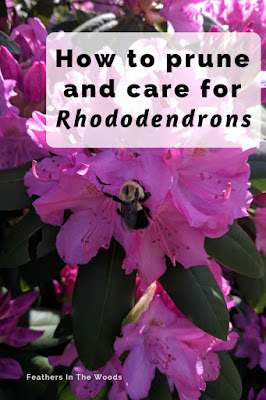When we bought our house there were many perennial flowers and bushes planted throughout the backyard. One one side were 2 azalea bushes and on the other side was 1 rhododendron bush that has tripled in size over the last 10 years!My husband hates that big thing! lol I love it though and it seems like the less I care for it the better it does. Pretty much the only thing I do to care for the rhododendron is to toss some bird seed under it every few days in the summer.
Ok, that sounded weirder than it actually is! I have chickens and the little ones like to go under the rhododendron bush. They hide from the adult chickens and the guinea fowl under there.Of course while they're hanging out they poop from time to time which delivers a nitrogen rich fertilizer right above the roots.
If I didn't have chickens adding fertilizer I would have to do it manually, but as it is chicken manure is great for fertilizing plants!
Thankfully chickens don't usually eat things that are bad for them which is a good thing since rhododendrons are poisonous to people and animals.
Obviously I didn't choose either plant but if I had I would have picked the rhododendron. I prefer it's flower clusters and size to the azaleas, they are mighty similar though and there's a good reason why.
I like to do a little foraging every year in early spring. I'm ready for my garden to start producing and it's entirely too early, but the warm weather has me itching for garden activities! So I do some foraging since many native plants are ready to be harvested before the garden even gets planted. Plantain is plentiful this time of year as are wild violets.
Violets are one of my favorite flowers to forage and use for teas and syrups because not only do violets taste good and have some amazing healing properties, but they turn everything a beautiful purple color!
While these pretty little flowers are one of the first blooms of spring, they don't last long so pick them while you can. In fact, harvest as much violet as you need for the year because they won't be back till next year! (ethically foraging them of course) Violet has been used for centuries for it's many healing properties.
Both the flower and the leaves of the wild violet are edible but the stems are not. The flowers and leaves can be eaten raw or cooked. Violet leaves contain fiber, vitamins A & C and have antioxidant and anti-inflammatory properties. They are used to encourage healing and soothe the digestive, respiratory and urinary tracts.
I think the easiest way to take violet is by making violet tea or tincture.
My herb garden has a tendency to take over the rest of my garden! I blame myself of course. It seems like I plant a lot of herbs that sort of run wild and spread, especially the catnip, lemon balm and Valerian! The one herb that I managed to plant correctly though is mint. That's actually a rather unfortunate situation though because while my mint has remained perfectly contained in it's planter, I would actually love for it to spread a bit!
I have been growing mint for about 8 years now. I've had the same plant the whole time. It's been so long that I can't actually remember what variety of mint I planted, but it does work very well in both foods and medicine.
Mint is a perennial and will last for many years with very little care. It also has a tendency to spread and take over the garden as I discussed in 9 Herbs that want to take over your garden.
Though mint is mostly known for its use in candy and dental care products, it's oldest reference has to do with it being used like currency because of it's high value. In ancient Athens mint was used to perfume the arms.
Mentha (also known as mint, from Greek míntha, is a genus of plants in the family Lamiaceae (mint family). It is estimated that 13 to 18 species exist, and the exact distinction between species is still unclear. Basil, catnip and lemon balm are also members of the mint family and all are pretty well known for their medicinal qualities.
Mint is a natural anti-inflammatory, has antimicrobial properties and is very high in antioxidants. It can be used to soothe the stomach, ease the pain of a headache, reduce oil production on skin or take the pinch out of a bug bite.



